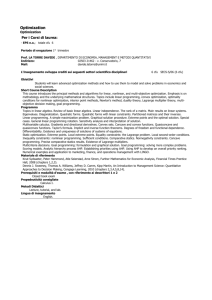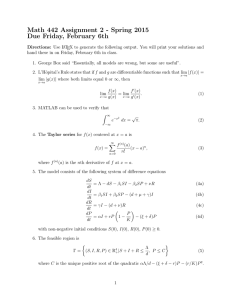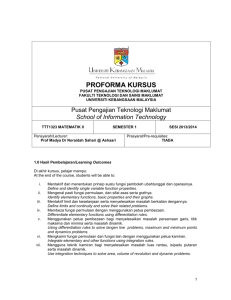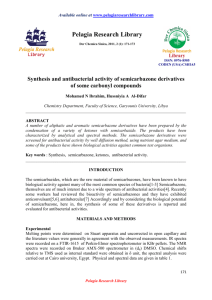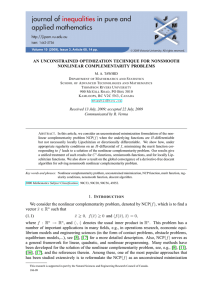Document 10677195
advertisement
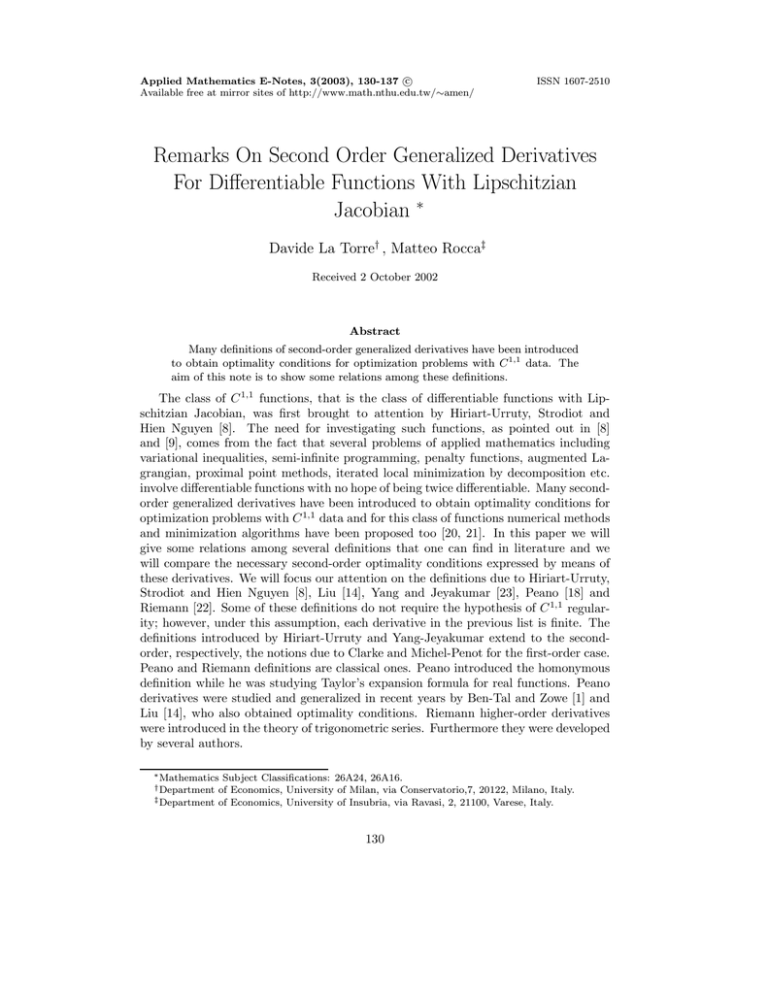
Applied Mathematics E-Notes, 3(2003), 130-137 c
Available free at mirror sites of http://www.math.nthu.edu.tw/∼amen/
ISSN 1607-2510
Remarks On Second Order Generalized Derivatives
For Differentiable Functions With Lipschitzian
Jacobian ∗
Davide La Torre† , Matteo Rocca‡
Received 2 October 2002
Abstract
Many definitions of second-order generalized derivatives have been introduced
to obtain optimality conditions for optimization problems with C 1,1 data. The
aim of this note is to show some relations among these definitions.
The class of C 1,1 functions, that is the class of differentiable functions with Lipschitzian Jacobian, was first brought to attention by Hiriart-Urruty, Strodiot and
Hien Nguyen [8]. The need for investigating such functions, as pointed out in [8]
and [9], comes from the fact that several problems of applied mathematics including
variational inequalities, semi-infinite programming, penalty functions, augmented Lagrangian, proximal point methods, iterated local minimization by decomposition etc.
involve differentiable functions with no hope of being twice differentiable. Many secondorder generalized derivatives have been introduced to obtain optimality conditions for
optimization problems with C 1,1 data and for this class of functions numerical methods
and minimization algorithms have been proposed too [20, 21]. In this paper we will
give some relations among several definitions that one can find in literature and we
will compare the necessary second-order optimality conditions expressed by means of
these derivatives. We will focus our attention on the definitions due to Hiriart-Urruty,
Strodiot and Hien Nguyen [8], Liu [14], Yang and Jeyakumar [23], Peano [18] and
Riemann [22]. Some of these definitions do not require the hypothesis of C 1,1 regularity; however, under this assumption, each derivative in the previous list is finite. The
definitions introduced by Hiriart-Urruty and Yang-Jeyakumar extend to the secondorder, respectively, the notions due to Clarke and Michel-Penot for the first-order case.
Peano and Riemann definitions are classical ones. Peano introduced the homonymous
definition while he was studying Taylor’s expansion formula for real functions. Peano
derivatives were studied and generalized in recent years by Ben-Tal and Zowe [1] and
Liu [14], who also obtained optimality conditions. Riemann higher-order derivatives
were introduced in the theory of trigonometric series. Furthermore they were developed
by several authors.
∗ Mathematics
Subject Classifications: 26A24, 26A16.
of Economics, University of Milan, via Conservatorio,7, 20122, Milano, Italy.
‡ Department of Economics, University of Insubria, via Ravasi, 2, 21100, Varese, Italy.
† Department
130
D. L. Torre and M. Rocca
131
In the following Ω will denote an open subset of Rn .
DEFINITION 1. A function f : Ω → R is locally Lipschitz at x0 when there exist
a constant K and a neighbourhood U of x0 such that
|f (x) − f (y)| ≤ K x − y , ∀x, y ∈ U.
DEFINITION 2. A function f : Ω → R is of class C 1,1 at x0 when its first order
partial derivatives exist in a neighbourhood of x0 and are locally Lipschitz at x0 .
Some possible applications of C 1,1 functions are shown in the following examples.
EXAMPLE 1. Let g : Ω ⊂ Rn → R be twice continuously differentiable on Ω and
consider f (x) = [g + (x)]2 where g + (x) = max{g(x), 0}. Then f is C 1,1 on Ω.
EXAMPLE 2. Let fi : Rn → R, i = 0, ..., m, and consider the following minimization problem:
min f0 (x)
over all x ∈ Rn such that f1 (x) ≤ 0, ..., fm (x) ≤ 0. Letting r denote a positive
parameter, the augmented Lagrangian Lr is defined on Rn × Rm as
Lr (x, y) = f0 (x) +
m
1 [
{[yi + 2rfi (x)]+ }2 − yi2 .
4r i=1
From the general theory of duality which yields Lr as a particular Lagrangian, we
know that Lr (x, ·) is concave and also that Lr (·, y) is convex whenever the minimization
problem is a convex minimization problem. By stating y = 0 in the previous expression,
we observe that
m
[
Lr (x, 0) = f0 (x) + r
[fi+ (x)]2
i=1
is the ordinary penalized version of the minimization problem. Lr is differentiable
everywhere on Rn × Rm with
∇x Lr (x, y) = ∇f0 (x) +
m
[
[yj + 2rfj (x)]+ ∇fj (x),
j=1
q
∂Lr
yi r
(x, y) = max fi (x), −
, i = 1, ..., m.
∂yi
2r
When the fi are C 2 on Rn , Lr is C 1,1 on Rn+m . The dual problem corresponding to
Lr is by definition
max gr (y)
over y ∈ Rm , where gr (y) = inf x∈Rn Lr (x, y). In the convex case, with r > 0, gr is
again a C 1,1 concave function with the following uniform Lipschitz property on ∇gr :
∇gr (y) − ∇gr (x) ≤
1
y − y , ∀y, y ∈ Rm .
2r
132
Generalized Derivatives
In [11] the authors have proved the following result which gives a characterization
of C 1,1 functions by divided differences.
THEOREM 1. [11] Assume that the function f : Ω → R is bounded on a neighbourhood of the point x0 ∈ Ω. Then f is of class C 1,1 at x0 if and only if there exist
δ d f (x;h)
neighbourhoods U of x0 and V of 0 ∈ R such that 2 h2
is bounded on U × V \{0},
∀d ∈ S 1 = {d ∈ Rn : d = 1} where
δ2d f (x; h) = f (x + 2hd) − 2f (x + hd) + f (x).
It is known [23] that if a function f is of class C 1,1 at x0 then it can be expressed
(in a neighbourhood of x0 ) as the difference of two convex functions. The following
corollary strenghtens the results in [23].
COROLLARY 1. If f is of class C 1,1 at x0 , then f = f˜ + p where f˜ is convex and
p is a polynomial of degree at most two.
PROOF. From the previous theorem we know that a function f is of class C 1,1 at
x0 if and only if the following difference:
f (x + 2hd) − 2f (x + hd) + f (x)
δ2d f (x; d)
=
h2
h2
is bounded by a constant M for each x in a neighbourhood U of xS
0 , for each h in a
neighbourhood V of 0 and d ∈ S 1 . If p(x) = p(x1 , x2 , . . . , xn ) = ni,j=1 cij xi xj is a
polynomial of degree 2 in the variables x1 , x2 , . . ., xn , it is well known that
n
[
δ2d p(x; d)
=
cij di dj
h2
i,j=1
where d = (d1 , d2 , . . . dn ). So we can choose the polynomial p such that
sup
d∈S 1
δ2d p(x; d)
≤ −M
h2
and then for the function f˜(x) = f (x) − p(x) the following inequality holds
δ2d f˜(x; d)
≥ 0, ∀x ∈ U, h ∈ V, d ∈ S 1
h2
that is f˜ is locally convex.
Now we remember the notions of second-order generalized derivative on which we
will focus our attention. The following definitions can be introduced without the hypothesis that f is of class C 1,1 but were investigated mostly under this hypothesis.
DEFINITION 3. Let us consider a function f : Ω → R of class C 1,1 at x0 .
i) Peano’s second order derivative of f at x0 in the direction d ∈ Rn is defined as
f P (x0 ; d) = 2 lim sup
t→0+
f (x0 + td) − f (x0 ) − t∇f (x0 )d
.
t2
D. L. Torre and M. Rocca
133
ii) Riemann’s second upper derivative of f at x0 in the direction d ∈ Rn is defined
as
f (x0 + 2td) − 2f (x0 + td) + f (x0 )
f R (x0 ; d) = lim sup
.
t2
+
t→0
iii) Yang-Jeyakumar’s second upper derivative of f at x0 in the directions u, v ∈ Rn
is defined as
f Y (x0 ; u, v) = sup lim sup
z∈Rn
t→0+
∇f (x0 + tu + tz)v − ∇f (x0 + tz)v
.
t
iv) Hiriart-Urruty’s second upper derivative of f at x0 in the direction u, v ∈ Rn is
defined as
∇f (x + tu)v − ∇f (x )v
f H (x0 ; u, v) = lim sup
.
t
3
+
x →x, t→0
REMARK 1. Analogously one can define lower derivatives. In particular Peano’s
second lower derivative is defined by
f P (x0 ; d) = 2 lim inf
+
t→0
f (x0 + td) − f (x0 ) − t∇f (x0 )d
.
t2
(x0 )d
the
REMARK 2. We will denote by f D (x0 ; d) = lim supt→0+ ∇f (x0 +td)d−∇f
t
n
classical second upper derivative of f at x0 in the direction d ∈ R .
The following result is trivial.
THEOREM 2. If f : Ω → R is of class C 1,1 at x0 , then each derivative in the
previous list is finite (the same holds for lower derivatives).
It is known that the following necessary optimality conditions for an unconstrained
minimization problem hold.
THEOREM 3. [6, 8, 14, 23] Let f : Ω → R be a C 1,1 function and assume that
x0 ∈ Ω is a local minimum point of f . Then ∀d ∈ Rn the derivatives f H (x0 ; d, d),
f Y (x0 ; d, d), f P (x0 ; d), f R (x0 ; d), f P (x0 ; d), are greater or equal than zero.
In the following we will give some relations among the derivatives in Definition 3
that we will allow us to state that the “best” necessary optimality conditions for an
unconstrained minimization problem are those expressed by means of Peano’s second
upper derivative.
REMARK 3. In [23] is given the following chain of inequalities
f D (x0 ; d) ≤ f Y (x0 ; d, d) ≤ f H (x0 ; d, d).
Furthermore f Y (x0 ; d, d) = f H (x0 ; d, d) if and only if the map f Y (·; d, d) is upper
semicontinuous [23].
REMARK 4. In [5] is given the following characterization of Hiriart-Urruty’s generalized derivative
u,v
∆2 f (y; s, t)
f H (x0 ; u, v) = lim sup
st
y→x0 ,s,t→0+
134
Generalized Derivatives
where
u,v
∆2 f (y; s, t) = f (y + su + tv) − f (y + su) − f (y + tv) + f (y).
From this characterization one can trivially deduce that f R (x0 ; d) ≤ f H (x0 ; d, d).
LEMMA 1. Let f : Ω ⊂ Rn → R be a given C 1,1 function. Then f R (x; d) ≤
2f P (x; d) − f P (x; d).
PROOF. Choose tn → 0+ as n → +∞, such that
L = lim
n→+∞
f (x + 2tn d) − 2f (x + tn d) + f (x)
.
t2n
Obviously L ≤ f R (x; d). Let now
s1,n = 2
and
s2,n = 2
f (x + tn d) − f (x) − tn ∇f (x)d
t2n
f (x + 2tn d) − f (x) − 2tn ∇f (x)d
,
t2n
eventually by extracting subsequences, s1,n → s1 and s2,n → s2 with s1 ≥ f P (x; d)
and s2 ≤ 4f P (x; d). By a simple calculation, we have
s2,n − 2s1,n = 2
f (x + 2tn d) − 2f (x + tn d) + f (x)
→ 2L
t2n
and then
2L = lim s2,n − 2s1,n ≤ 4f P (x; d) − 2f P (x; d).
n→+∞
THEOREM 4. Let f be a function of class C 1,1 at x0 . Then
i) f P (x0 ; d) ≤ f D (x0 ; d) ≤ f Y (x0 ; d, d) ≤ f H (x0 ; d, d).
ii) f P (x0 ; d) ≤ f R (x0 ; d) ≤ f Y (x0 ; d, d) ≤ f H (x0 ; d, d).
PROOF.
i) From the previous remarks, it is only necessary to prove the inequality f P (x0 ; d) ≤
f D (x0 ; d). If we take the function φ1 (t) = f (x0 + td) − t∇f (x0 )d and φ2 (t) = t2 ,
applying Cauchy’s theorem, we obtain
2
φ1 (t) − φ1 (0)
f (x0 + td) − f (x0 ) − t∇f (x0 )d
=2
=
2
t
φ2 (t) − φ2 (0)
2
φ1 (ξ)
∇f (x0 + ξd)d − ∇f (x0 )d
=
,
φ2 (ξ)
ξ
where ξ = ξ(t) ∈ (0, t), and then f P (x0 ; d) ≤ f D (x0 ; d).
D. L. Torre and M. Rocca
135
ii) From the previous remarks, it is only necessary to prove the inequalities f P (x0 ; d) ≤
f R (x0 ; d) ≤ f Y (x0 ; d, d). Concerning the first inequality, from the definition of
f P (x0 ; d) we have
f (x0 + td) = f (x0 ) + t∇f (x0 )d +
where lim supt→0+
g(t)
t2
t2
f (x0 ; d) + g(t)
2 P
= 0 and
f (x0 + 2td) = f (x0 ) + 2t∇f (x0 )d + 2t2 f P (x0 ; d) + g(2t)
where lim supt→0+
g(2t)
t2
= 4 lim supt→0+
g(2t)
4t2
= 0. Then
f (x0 + 2td) − 2f (x0 + td) + f (x0 )
t2 f P (x0 ; d) + g(2t) − g(t)
=
≥
t2
t2
f P (x0 ; d) + lim sup
t→0+
g(2t)
g(t)
− lim sup 2 .
t2
t
+
t→0
Then f R (x0 ; d) ≥ f P (x0 ; d). For the second inequality, we define φ1 (t) = f (x0 +
2td) − 2f (x0 + td) and φ2 (t) = t2 . Then, by Cauchy’s theorem, we obtain
φ1 (t) − φ1 (0)
f (x0 + 2td) − 2f (x0 + td) + f (x0 )
=
=
t2
φ2 (t) − φ2 (0)
∇f (x0 + 2ξd)d − ∇f (x0 + tξ)d
φ1 (ξ)
=
,
φ2 (ξ)
ξ
where ξ = ξ(t) ∈ (0, t), and then f R (x0 ; d) ≤ f Y (x0 ; d, d).
THEOREM 5. Let f be a function of class C 1,1 at x0 . If x0 is a local minimum for
f , then ∇f (x0 ) = 0 and the following chain of inequalities holds
0 ≤ f P (x0 ; d) ≤ f P (x0 ; d)
≤ f R (x0 ; d) ≤ 2f D (x0 ; d) ≤ 2f Y (x0 ; d, d) ≤ 2f H (x0 ; d, d)
Indeed, the proof follows from Theorem 4 and Lemma 1.
REMARK 5. From the previous theorem one can conclude that the “best” optimality conditions for an unconstrained minimization problem with C 1,1 objective function
are those expressed by means of Peano’s derivatives.
REMARK 6. A similar chain of inequalities holds ∀x ∈ Ω when f is convex and
of class C 1,1 . In fact in this case it is not difficult to prove that f R (x; d) ≤ 4f D (x; d)
and then, reasoning as in the proof of Theorem 5, we obtain the following chain of
inequalities
0 ≤ f P (x; d) ≤ f P (x; d)
≤ f R (x; d) ≤ 4f D (x; d) ≤ 4f Y (x; d, d) ≤ 4f H (x; d, d).
136
Generalized Derivatives
References
[1] A. Ben-Tal and J. Zowe, Directional derivatives in nonsmooth optimization, Journal of Optimization Theory and Applications, 47(4)(1985), 483—490.
[2] J. M. Borwein J. M., S. P. Fitzpatrick and J. R. Giles, The differentiability of
real functions on normed linear space using generalized subgradients, Journal of
Mathematical Analysis and Applications, 128(1987), 512—534.
[3] W. L. Chan, L. R. Huang and K. F. Ng, On generalized second-order derivatives and Taylor expansion formula in nonsmooth optimization, SIAM Journal on
Control and Optimization, 32(3)(1994), 591—611.
[4] F. H. Clarke, Optimization and Nonsmooth Analysis, Wiley, New York, 1983.
[5] R. Cominetti and R. Correa, A generalized second-order derivative in nonsmooth
optimization, SIAM Journal Control and Optimization, 28(1990), 789—809.
[6] I. Ginchev and A. Guerraggio, Second order optimality conditions in nonsmooth
unconstrained optimization, Pliska Studia Mathematica Bulgarica, 12(1998), 39—
50.
[7] A. Guerraggio and D.T. Luc, On optimality conditions for C 1,1 vector optimization
problems, Journal of Optimization Theory and Applications, 109(3)(2001), 615—
629.
[8] J. B. Hiriart-Urruty, J. J. Strodiot and H. V. Nguyen, Generalized Hessian matrix and second order optimality conditions for problems with C 1,1 data, Applied
Mathematics and Optimization, 11(1984), 43—56.
[9] D. Klatte and K. Tammer, On second-order sufficient optimality conditions for
C 1,1 optimization problems, Optimization, 19(1988), 169—179.
[10] D. Klatte, Upper Lipschitz behavior of solutions to perturbed C 1,1 programs.
Mathematical Programming (Ser. B), 88(2000), 285—311.
[11] D. La Torre and M. Rocca, C 1,1 functions and optimality conditions, Journal of
Computational Analysis and Applications, to appear.
[12] D. La Torre and M. Rocca, On C 1,1 constrained optimization problems, Journal
of Computational Analysis and Applications, to appear.
[13] D. La Torre and M. Rocca, A characterization of C k,1 functions, Real Analysis
Exchange, 27(2)(2002), 515—534.
[14] L. Liu and M. Krisek, Second order optimality conditions for nondominated solutions of multiobjective programming with C 1,1 data, Applications of Mathematics,
45(5)(2000), 381—397.
[15] D.T. Luc, Taylor’s formula for C k,1 functions, SIAM Journal on Optimization,
5(1995), 659—669.
D. L. Torre and M. Rocca
137
[16] P. Michel and J. P. Penot, Calcul sous-différential pour des fonctions lischitziennes an nonlipschitziennes, Comptes Rendus de l’Academie des Sciences Paris,
298(1984), 269—272.
[17] H. W. Oliver, The exact Peano derivative, Transaction Amererican Mathematical
Sociecty, 76(1954), 444—456.
[18] G. Peano, Sulla formula di Taylor, Atti dell’Accademia delle Science di Torino,
27(1891-92), 40—46.
[19] L. Qi and W. Sun, A nonsmooth version of Newton’s method, Mathematical Programming, 58(1993), 353—367.
[20] L. Qi, Superlinearly convergent approximate Newton methods for LC 1 optimization problems, Mathematical Programming, 64(1994), 277-294.
[21] L. Qi, LC 1 functions and LC 1 optimization, Operations Research and its applications (D.Z. Du, X.S. Zhang and K. Cheng eds.), World Publishing, Beijing, 1996,
4—13.
[22] B. Riemann, Uber die darstellbarkeit einen function durch eine trigonometrische
reihe, Ges. Werke, 2 Aufl., Leipzig (1982), 227—271.
[23] X. Q. Yang and V. Jeyakumar, Generalized second-order directional derivatives
and optimization with C 1,1 functions, Optimization, 26(1992), 165—185.
